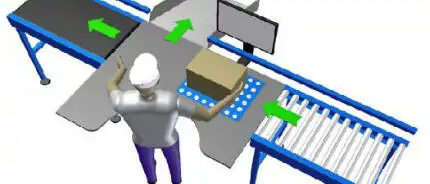The aim of warehouse ergonomics is to adapt and create workplaces that, taking into account the human physique, enable the worker to carry out activities as comfortably as possible. At first glance, this seems to conflict with the aspect of economic efficiency: customers’ increasing demands for faster availability of the ordered products are putting immense pressure on companies and their workers in the global market. However, taking workplace ergonomics into account (e.g. by improving lighting conditions, setting lifting limits based on body weight and ensuring work is varied) has a positive effect on the economic aspect: employee motivation increases and they are absent due to illness less often. In addition, as warehouses are automated with the help of cyber-physical systems, work processes can be accelerated and the burden on employees reduced.
The reasons for taking workplace ergonomics into account
- Body limit despite increased performance expectations due to global competition
- Sick leave due to physical strain
- Demographic change
- Demand for attractive jobs
- Expected increase in performance through varied work
- Responsibility of companies towards their employees
While the work steps in the warehouse (e.g. picking, packing) have to be performed faster and faster, human strength is naturally limited. According to the statistics portal Statista, musculoskeletal disorders were the main cause of sick leave in the years 2010-2015, accounting for 21.7 percent of all cases. In addition, demographic change and the growing demand for attractive jobs in the logistics industry are increasingly bringing the ergonomic design of workplaces into focus.
According to the evaluations by Statista, Germany expects a social decline from currently 80,000 to around 65,000 people in 2060. Because there are too few young people, industry is dependent on the use of older workers. In addition, the young generation will have to expect a retirement age of 67 years, which is two years higher than before. These facts will ensure that the average age of the workforce will also rise. This presents challenges for intralogistics. For example, a 60-year-old employee cannot cover the same distances or lift the same loads as a 30-year-old employee. The industry needs solutions that provide an individual and healthy workflow for each age group and physical condition.
Examples of ergonomics in the warehouse
For the operation of shelf zones in the warehouse, logistics provides a sensible allocation for the storage of goods that enables ergonomic picking by the worker, depending on weight, priority and picking frequency. The layout of a shelf is therefore divided into the bending, reaching, viewing and stretching zones, which are based on the operation of an average-sized adult.
According to the German Social Accident Insurance Institution for the health and welfare services (Berufsgenossenschaft für Gesundheitsdienst und Wohlfahrtspflege, BGW), warehousing and transportation are still among the most accident-prone activities in intralogistics. The BGW has therefore developed measures that companies can use as a guide for safety and ergonomics in the workplace. These guidelines include, for example, ensuring free traffic routes, sufficient workspace, good lighting conditions and a pleasant room climate to protect employees and improve ergonomics at their workplaces.
Further precautions for providing a healthy workplace include reducing noise at work and avoiding unnecessary walking distances, which can be achieved by using an efficient material flow controller (MFC). In addition, batch formation contributes to the best possible line utilization by combining orders in a meaningful way.
Cyber-physical systems are increasingly being used to physically relieve workers. These interlink man and machine and combine their electronic and mechanical work steps via an interface. The aim is to automate the employee’s work to such an extent that he or she no longer perceives the machine as a control unit, but rather as a self-contained work process.
Corporate responsibility and employee satisfaction
Taking the best possible account of health aspects in the workplace also brings the aspect of varied work design into focus. Tasks within a warehouse that require, for example, running, bending or lifting heavy loads, are subject to a monotony that puts an equal strain on the physical and mental health, even with regulating limitations based on kilograms, kilometers or time frames. The solution for the employee in practice could mean, for example, a change of job to a sedentary activity after completing a three-kilometre run.
To help companies fulfil their responsibility to their warehouse employees, a control center can help to plan and distribute tasks ergonomically.
The article “Material flow control as a service for a distribution center” provides further information on how the flow of goods in intralogistics can be routed through the warehouse in the fastest and most economical way.
Thumbnail: Lesconvoyeurs (License: CC-BY-SA-4.0)
